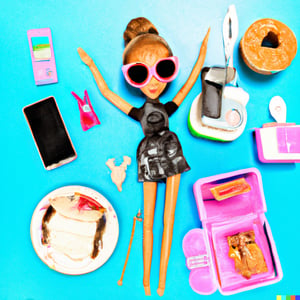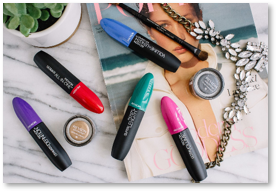We have a lot of experience working with beauty brands doing influencer marketing. Over the years, we've seen some trends across the industry, whether you’re a drugstore brand operating at a lower cost, or a boutique brand operating at higher cost.
We recently chatted with Susan Flower, our Senior Production Manager and beauty brand influencer expert, to share our top 15 tips for beauty brands doing influencer marketing.
If you prefer to read along, we’ve summarized many of the highlights of the discussion in this post.
How to Do Influencer Marketing: Tips for Beauty Brands
1. Avoid "shill anything barbie"
 Beauty influencers like to try all kinds of products. They simply aren't monogamous. And that's ok. They are always looking for their favorite new product and want to show their audience a variety of looks to keep them engaged.
Beauty influencers like to try all kinds of products. They simply aren't monogamous. And that's ok. They are always looking for their favorite new product and want to show their audience a variety of looks to keep them engaged.
But you have to be realistic about who you choose and how much sponsored content they do. You don’t want to hire “Shill Anything Barbie” who will say any product is fantastic no matter what it is, because her review won’t carry much weight for your brand.
Instead, you want to strategically hire creators who give authentic, honest reviews about a variety of products.
2. Intentionally select diverse influencers
When choosing creators to hire, you want to select a diverse set of influencers with interesting stories and perspectives they can weave into your products.
If people hear interesting, positive things about your product from a variety of people and points of view, they are more likely to trust the reviews and try the product.
3. Partner with influencers to create hauls, how-tos, and tutorials
Beauty hauls, how-tos, and tutorials do very well in the beauty space, so we recommend them for any beauty brand.
People love to see how a product works and how to create different looks with it. Seeing someone’s experience with a product is more likely to lead to conversions than just being told about it.
4. Allow time for beauty influencers to use your product
It can take time to form an opinion about a beauty product. Creators have to see how it applies, how it wears throughout the day or night, and how they best like to use it.
When creating partnerships, allow plenty of time for influencers to actually use your product. This will help them speak more authentically about your products and consumers will pick up on it and appreciate it.
5. Provide good online offers
This applies to unknown ecommerce brands in particular. You need to provide good offers that people will want to pay for.
For example, we worked with a client that set the threshold for free shipping too high to convert new customers. The brand saw a large increase in website traffic and clicks, but they also saw unusually high cart abandonment rates. When we lowered the free shipping threshold, conversion rates went up.
Leverage offers, such as adding a promotion at a specific retailer, a BOGO sale, a free product with purchase, or a limited-time sale to create that FOMO with your audiences.
6. Optimize as you go
Optimization is especially relevant for ecommerce brands, but it applies to all programs. Be prepared to optimize your targeting as you go. Experiment and figure out what drives the best ROAS.
Of course, this is trickier with Amazon programs because the tracking breaks on the product pages. Instead, you can measure pre-, during and post-campaign to see your lift.
7. Avoid general messages
General messages about your product, such as “the best lip gloss,” are vague and ineffective. Consumers probably see five lip glosses per day that all claim to be “the best.”
Instead, get specific and tell your consumers why they should buy your product. What makes it special?
8. Tie the creative into the offer
 Whenever possible, tie the creative into the offer.
Whenever possible, tie the creative into the offer.
For example, we had a BOGO promotion for Revlon mascara where we did mascara “cocktailing” with the creative. This required multiple brush types in the creative, which exposed consumers to a variety of products instead of just one.
9. Save money as a well-known brand
We have found that well-known brands typically do not have to pay as much for influencer marketing as unknown brands do.
Some influencers prefer the credibility of working for a major brand, so they are willing to work for a smaller budget as a tradeoff for the exposure and clout.
10. Show in-store content
If you are a beauty retailer or partner with a beauty retailer, we recommend showing in-store content. This will emphasize to consumers where they can buy your product.
11. Have a consistent message

Consistent messaging is helpful for any brand, and it is especially important for a new beauty brand. Consumers typically don’t buy something the first time they hear about it, so you want to maintain a consistent campaign over time.
Ideally, budget for a six-month program. You can maximize your campaign budget by hiring VIP influencers for longer-term deals because their content typically has a higher ROI.
12. THINK ABOUT DEINFLUENCING
Deinfluencing is a new trend where influencers share products they would NOT buy, instead of telling them what they should buy. Of course, these are typically not sponsored posts.
Some brands are scared of deinfluencing as a trend. And if you're selling flawed products, you probably should be. But influencers can come across as disingenuous if they love every product they ever use. Therefore, negative reviews, or “de-influencing,” can boost engagement and increase authenticity for when an influencer does say good things.
13. Follow FTC compliance
A shocking amount of sponsored beauty content goes undisclosed. Not disclosing sponsored content could result in fines and diminish consumer trust around your brand.
Always follow FTC compliance rules when working with beauty influencers.
14. Use beauty filters and spark debate
Using filters on beauty content is naturally controversial. People who see it being done are not against trashing brands that do so.
For example, in January 2023, TikTok influencer Mikayla Nogueira posted a sponsored review of L’Oréal’s Telescopic Lift Mascara. Viewers quickly called her out for seemingly wearing false eyelashes yet saying her lashes were the result of the mascara.
In this case, it may have worked out for the brand. People quickly took to the comments, boosting engagement on her post and earning her video more than 60M views (when her average is 2.4M view). People even bought the mascara to attempt to prove she was wearing false eyelashes, only to end up loving the product. This will not, of course, always be the case. So be careful.
@mikaylanogueira THESE ARE THE LASHES OF MY DREAMS!! @lorealparisusa never lets me down 😭 #TelescopicLift #LorealParisPartner #LorealParis @zoehonsinger ♬ original sound - Mikayla Nogueira
15. Know your influencers’ history
Doing your homework and researching your influencers before partnering with them is important. For example, if they only talk about drug store brands and you’re a high-end brand, their followers will know that and be wary of their review of your product.
Summary
Influencer marketing for the beauty industry has its own set of rules and norms. Hopefully these 15 tips will help make sure your campaign is successful. If you'd like to talk to us about helping with your campaign, please complete the form below and we'll quickly reach back out.
-1.png?width=504&height=360&name=Carusele%20logo%20%C2%AE%20logo%20Color%20(2)-1.png)